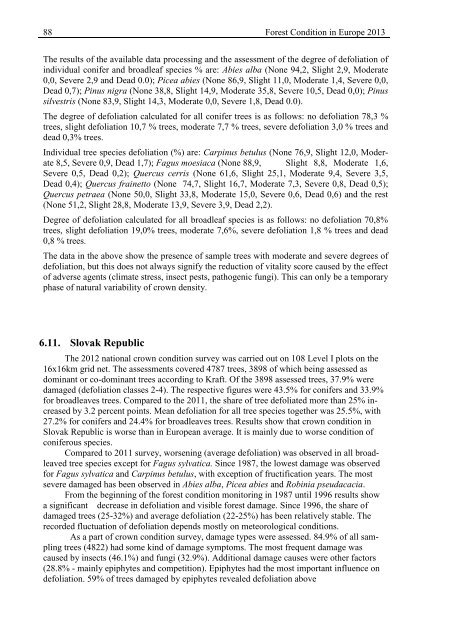Forest Condition in Europe - ICP Forests
Forest Condition in Europe - ICP Forests
Forest Condition in Europe - ICP Forests
You also want an ePaper? Increase the reach of your titles
YUMPU automatically turns print PDFs into web optimized ePapers that Google loves.
88 <strong>Forest</strong> <strong>Condition</strong> <strong>in</strong> <strong>Europe</strong> 2013<br />
The results of the available data process<strong>in</strong>g and the assessment of the degree of defoliation of<br />
<strong>in</strong>dividual conifer and broadleaf species % are: Abies alba (None 94,2, Slight 2,9, Moderate<br />
0,0, Severe 2,9 and Dead 0.0); Picea abies (None 86,9, Slight 11,0, Moderate 1,4, Severe 0,0,<br />
Dead 0,7); P<strong>in</strong>us nigra (None 38,8, Slight 14,9, Moderate 35,8, Severe 10,5, Dead 0,0); P<strong>in</strong>us<br />
silvestris (None 83,9, Slight 14,3, Moderate 0,0, Severe 1,8, Dead 0.0).<br />
The degree of defoliation calculated for all conifer trees is as follows: no defoliation 78,3 %<br />
trees, slight defoliation 10,7 % trees, moderate 7,7 % trees, severe defoliation 3,0 % trees and<br />
dead 0,3% trees.<br />
Individual tree species defoliation (%) are: Carp<strong>in</strong>us betulus (None 76,9, Slight 12,0, Moderate<br />
8,5, Severe 0,9, Dead 1,7); Fagus moesiaca (None 88,9, Slight 8,8, Moderate 1,6,<br />
Severe 0,5, Dead 0,2); Quercus cerris (None 61,6, Slight 25,1, Moderate 9,4, Severe 3,5,<br />
Dead 0,4); Quercus fra<strong>in</strong>etto (None 74,7, Slight 16,7, Moderate 7,3, Severe 0,8, Dead 0,5);<br />
Quercus petraea (None 50,0, Slight 33,8, Moderate 15,0, Severe 0,6, Dead 0,6) and the rest<br />
(None 51,2, Slight 28,8, Moderate 13,9, Severe 3,9, Dead 2,2).<br />
Degree of defoliation calculated for all broadleaf species is as follows: no defoliation 70,8%<br />
trees, slight defoliation 19,0% trees, moderate 7,6%, severe defoliation 1,8 % trees and dead<br />
0,8 % trees.<br />
The data <strong>in</strong> the above show the presence of sample trees with moderate and severe degrees of<br />
defoliation, but this does not always signify the reduction of vitality score caused by the effect<br />
of adverse agents (climate stress, <strong>in</strong>sect pests, pathogenic fungi). This can only be a temporary<br />
phase of natural variability of crown density.<br />
6.11. Slovak Republic<br />
The 2012 national crown condition survey was carried out on 108 Level I plots on the<br />
16x16km grid net. The assessments covered 4787 trees, 3898 of which be<strong>in</strong>g assessed as<br />
dom<strong>in</strong>ant or co-dom<strong>in</strong>ant trees accord<strong>in</strong>g to Kraft. Of the 3898 assessed trees, 37.9% were<br />
damaged (defoliation classes 2-4). The respective figures were 43.5% for conifers and 33.9%<br />
for broadleaves trees. Compared to the 2011, the share of tree defoliated more than 25% <strong>in</strong>creased<br />
by 3.2 percent po<strong>in</strong>ts. Mean defoliation for all tree species together was 25.5%, with<br />
27.2% for conifers and 24.4% for broadleaves trees. Results show that crown condition <strong>in</strong><br />
Slovak Republic is worse than <strong>in</strong> <strong>Europe</strong>an average. It is ma<strong>in</strong>ly due to worse condition of<br />
coniferous species.<br />
Compared to 2011 survey, worsen<strong>in</strong>g (average defoliation) was observed <strong>in</strong> all broadleaved<br />
tree species except for Fagus sylvatica. S<strong>in</strong>ce 1987, the lowest damage was observed<br />
for Fagus sylvatica and Carp<strong>in</strong>us betulus, with exception of fructification years. The most<br />
severe damaged has been observed <strong>in</strong> Abies alba, Picea abies and Rob<strong>in</strong>ia pseudacacia.<br />
From the beg<strong>in</strong>n<strong>in</strong>g of the forest condition monitor<strong>in</strong>g <strong>in</strong> 1987 until 1996 results show<br />
a significant decrease <strong>in</strong> defoliation and visible forest damage. S<strong>in</strong>ce 1996, the share of<br />
damaged trees (25-32%) and average defoliation (22-25%) has been relatively stable. The<br />
recorded fluctuation of defoliation depends mostly on meteorological conditions.<br />
As a part of crown condition survey, damage types were assessed. 84.9% of all sampl<strong>in</strong>g<br />
trees (4822) had some k<strong>in</strong>d of damage symptoms. The most frequent damage was<br />
caused by <strong>in</strong>sects (46.1%) and fungi (32.9%). Additional damage causes were other factors<br />
(28.8% - ma<strong>in</strong>ly epiphytes and competition). Epiphytes had the most important <strong>in</strong>fluence on<br />
defoliation. 59% of trees damaged by epiphytes revealed defoliation above
















